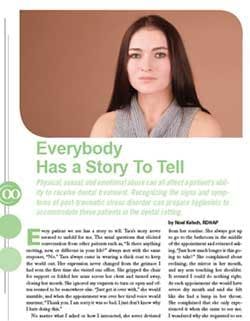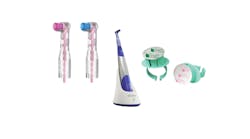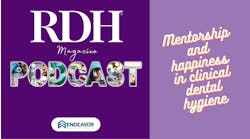To submit letters to the editor, send to: RDH, P.O. Box 3408, Tulsa, OK 74101; [email protected]; or (918) 831-9804 (fax).
Dear RDH:
We read with interest the article by Dianne Glasscoe, RDH, BS, published in the December 2007 issue of RDH. The article titled, "The Periodontal Patient Who Just Wants A Cleaning" (page 40), discusses in some detail a common problem confronted by both general dental and periodontal offices. However, we have a different take on Ms. Glasscoe’s philosophy and recommendations on how to handle such a patient. Given that Karen Davis and I also have slightly differing opinions, we are writing this letter in two sections.
Ms. Glasscoe discusses using the "informed consent" and "informed refusal" but fails to mention that the legal profession and the courts in particular have ruled that a practitioner cannot have the patient sign away that practitioner’s liability to meet the standard of care. Thus, the use of an informed refusal does not protect the practitioner from liability if the treatment rendered is not within the standard of care. Consequently, Ms. Glasscoe is caught in a conundrum.
Ms. Glasscoe appears to imply that by having good treatment record documentation, including a signed and witnessed informed refusal, the dental hygienist is protected against future liability. Thus, the dental hygienist can proceed to treat a patient with diagnosed periodontal disease by rendering a "cleaning" and attempting to educate the patient in hopes of convincing that patient to accept definitive care down the road. The conundrum is simply, does a "cleaning" in this case of diagnosed periodontal disease satisfy the standard of care? This issue has been addressed numerous times by the law and the answer is "no."1 A "cleaning" under such circumstances does not meet the requirement of rendering a "timely and appropriate manner" of care.1
I can appreciate Ms. Glasscoe’s concern for such patients and her desire to "reach" these individuals through education. However, my experiences as an expert witness and private practice periodontist over the last 40 years has made me acutely aware of the shortcomings of allowing patients to dictate how and when they are going to be treated. For those practitioners who have been sued and have lost cases that pivoted on this or a similar point, trying to satisfy the patient’s desires in spite of their presenting disease was not worth the outcome. Furthermore, given the body of accumulating evidence linking periodontal disease to a variety of systemic conditions, the liability is only going to increase and become more expensive.
Some patients just don’t want to get involved in anything more than a "cleaning" unless they are in distress. Even when the referring dentist has told them of existing disease and I have confirmed it — they don’t consider it a problem unless pain or loss of function is involved. Thus, there are patients willing to accept disease as long as it doesn’t interfere with their lifestyle. We all see walking pathology that is treatable — head and neck lipomas, large irritation fibromas, actinokeratotic lesions, basal cell carcinomas, etc. I see these types of problems all the time in airports. One can only imagine what their mouth must look like. To initiate treatment that does not meet the standard of care for this type of patient is misleading and open to legal problems. It often becomes supervised neglect because the patient begins to feel that they can avoid more expensive treatment by continued "cleanings."
My personal opinion is that Ms. Glasscoe’s article did not present both sides of this issue. Indeed, given the circumstances presented in the article, there is a very real possibility for a litigation that offers a very weak defense for the dental hygienist/dentist.
Charles M. Cobb, DDS, MS, PhD
Kansas City, Missouri
References
1. Cobb CM. Personal communication with Frank B. W. McCollum, JD, December 2007.
2. Cobb CM, Callan DP. Flash point in periodontics: Patient referral. Triage 2005;1(2):12-16.
Dear RDH:
I wish to express my opinion on the challenging subject addressed in the article titled, "The Periodontal Patient Who Just Wants A Cleaning."
I agree that professionals cannot always force patients make the right health decision. That said, it is our ethical obligation to present information that is clear and compelling where health issues are concerned, answer patient’s questions, discover what their objections are, and do everything we can to create value for necessary treatment. It has been my experience that when patients flatly decline necessary treatment, somewhere along the way the dental professional did not frequently and adequately supply the patient with what he or she needed to make a wise decision. Most patients, when well informed, do not choose to leave infection in their mouths untreated long term any more than they leave unresolved infection untreated in other parts of the body.
My experience has been that the most hesitant patients to proceed with necessary therapy are often existing patients who have now been informed that they need more than a routine cleaning to treat unresolved disease. They often think ... if only I’d been flossing, or how come you are just now informing me of this, or wait a minute ... is this just a ploy to pay for the doctor’s new car, and so forth. For these individuals, I have found the best method to achieve case acceptance is to let them see their own bone loss on the X-rays, see the hemorrhage in their mouths, and use plenty of visuals to help them understand the implications of leaving periodontal infection untreated.
If, after responding to whatever objections they have, and a clear diagnosis by the dentist, they are simply unconvinced that they need or can afford necessary treatment at this time, then I would suggest clear documentation in the patient’s record and a reassessment within six weeks to six months — whatever they will commit to — with this contingency: If the signs of periodontal infection are still present at the reassessment, it will require additional therapy to halt the disease process! For some existing patients, this is a necessary part of the decision-making process and taking ownership for their disease. The reality is that, upon the re-assessment, unless a miracle has occurred, they do still need treatment, and therapeutic treatment is then started. If, the patient flatly refuses therapy at the reassessment, this is an opportunity to suggest the patient find a different dental office that will simply clean teeth in the presence of active periodontal infection.
My personal standard of care has always been ... They need what they need ... and that is what I teach. If clinicians approach patient education from that perspective, then the greatest value to the patient is to help them understand and desire what they need. The alternative suggested by Dianne of providing a debridement as a better approach than no treatment for patients suffering from active periodontal infection raises the question of tissue tightening at the gingival margin with pathogenic biofilm and debris "trapped" subgingivally ... Is it really in the patient’s best interest clinically to perform partial debridement when what is necessary to treat the infection is meticulous dismantling of the biofilm and definitive root preparation? Partial debridement in a diseased subgingival environment would be below standard-of-care treatment in my opinion.
As a practicing dental hygienist, I am sensitive to the reality that not all patients value their health irrespective of the methods of education and clinical documentation. That said, I would rather risk losing a patient declining necessary treatment for infection of the mouth which we know can have systemic implications, rather than provide a substitute treatment lacking research to substantiate clinical value.
Karen Davis, RDH, BSDH
Dallas, Texas
Editor’s note: The above letters from Dr. Cobb and Ms. Davis arrived at our offices well before deadlines. We allowed the author, Dianne Glasscoe, RDH, to respond. Dianne’s article, by the way, was a response to a reader of her Staff Rx column. The reader was confused by a speaker who declared it was "outright fraud to do a prophy in the presence of disease."
Dianne’s response: First of all, a "cleaning" is not the same thing as debridement. Dr. Cobb seems to be implying that I have suggested a "cleaning" in lieu of perio care. I stated that I would never suggest that it is appropriate for a "cleaning" to be performed in the presence of frank periodontal disease. Nor am I suggesting a "gross scaling" as Ms. Davis suggests, but rather a debridement with a power scaler to rid pathogens from the sulcus that is meant to be a temporary measure to gain some time.
We can paint solutions for patients with wide brush strokes as we sit at our computers and elucidate. However, there are many variables with regard to patients. If a new patient presents with advanced periodontal disease, it is easier to dismiss that patient (when he refuses definitive care) than one in which we have built a relationship with over time. But is it right to dismiss a patient who is undergoing a tremendous amount of stress and presents a deteriorating periodontal condition when she just can’t juggle adding anything else to her plate (definitive periodontal disease) right now? Is it right to dismiss a struggling college student, unemployed furniture worker, or single parent for the same reason?
Every person has the right in this country to have a say in his or her care. Certainly, every dentist has the right to deny care. However, hygienists are caught in the middle. Doctors are often unwilling to dismiss patients, as Dr. Cobb has suggested they do, when the patient is unwilling or unable to pay for "state of the art" care. Should the hygienist defy the doctor/employer and refuse to deliver what Dr. Cobb feels is "substandard" care in such situations?
I mean no disrespect, but the reality is many people are struggling financially. Is it better to kick a divorced mother of three, struggling to keep her children clothed and fed, out of the practice simply because she cannot affort ideal treatment? Is it considered substandard care to provide a patient with a temporary alternative when the ideal is presently out of reach? That is the crux of the matter.
The legal counsel that I have conferred with agrees with my position that, as long as documentation is thorough, and the patient has been informed of the consequences of refusing referral to a periodontist or not proceeding with definitive nonsurgical treatment, the practice is not liable. Patients have the right of refusal.
The subset of patients we are discussing is growing with the worsening economic situation in this country. In nearly every lecture I present, someone asks the question, "Dianne, what do we do about the people who have periodontal disease but have no dental benefits and say they can’t afford the definitive care they need?"
Dear RDH:
I am a hygienist in San Francisco, and I have been practicing since 1996. I was thrilled to read your article in December RDH titled, "Periodontal Nitwits and Flossing".
I have recommended interdental brushes over flossing for so many patients — not only perio patients, but any patients with large embrasure spaces, possibly due to adjacent crown positioning or mal-aligned teeth or even lower anteriors. In fact, I think that many patients could not achieve the resolution they have without interdental brushes.
I was also happy to read that flossing devices are close to manual flossing, because I have always been concerned about the devices not being able to form the "C" shape I always recommend to follow the shape of the tooth.
I have always been the butt of jokes for being so "into" my job, but I do feel a passion for it and I think my patients can feel it.
Thank you for sharing your wisdom. Hopefully the nitwits read RDH and can pass this advice on to their patients — the real beneficiaries of the right tools.
Lorna Smith, RDH
San Francisco, California
Dear RDH:
In addition to the information presented in the Oral Exam article in the December, 2007 issue of RDH Magazine:
Early detection of oral cancer can be further enhanced with the use of the ViziLite® Plus system. The screening can be done in under two minutes and there is an ADA code (D0431) for the advanced cancer check. The ViziLite has been tested on over 14,000 patients with 99.9 percent accuracy. No more need for a brush biopsy or waiting to look for changes. The advanced technology allows for instantly knowing if cancer exists and further treatment is necessary.
Connie Sidder
Fort Collins, Colorado
Dear RDH:
"But before we can change the world, we need to examine our own personal habits." After reading the article "What are we drinking?" by Anne Nugent Guignon in RDH’s January 2008 magazine (page 32), I felt compelled to write. It is scary when we stop to think that half of the liquid we drink each year is leading us down a path to many health issues, including diabetes, obesity, caries, and osteoporosis. As a dental hygienist, it is our duty to inform and guide patients into better health care practices.
I would be unable to list the number of times that I shared a Web site of a really great product, or perhaps recommended a really great doctor I knew that would help a patient improve his or her overall health.
I want to share Monavie with you. I say that it’s time everyone knows all about Monavie. Monavie is a delicious fruit juice blend whose crown jewel is the acai berry found deep in the Amazon Rainforest. The acai (pronounced "ah-sigh-ee") berry is the number one super-fruit of the world. The acai berry is the only food on earth that is considered to be a whole food, which means that you could consume only the acai berry for a considerable amount of time and get the proper nutrition that your body requires.
If there indeed is a drink out there (Monavie) loaded with vitamins and minerals, antioxidants, phytonutrients, essential fatty acids (omega 3, 6, and 9), amino acids, complex carbohydrates, dietary fiber, trace minerals, and it tastes delicious and costs about $4.33 per day to drink, why aren’t people drinking it?
My guess is that this information is so new that it takes time to "get the word out."
I have been in the health-care field for over 24 years and never felt anything remotely close to how rewarding it feels to hear people tell me how Monavie has changed their lives. The stories I hear are endless. Monavie is not a cure, nor is it a medicine. However, it is improving the health and lives of so many people it’s ridiculous.
Heidi Sarno, RDH
Manahawkin, New Jersey
Editor’s Note: Ms. Sarno provided many examples of related literature on the acai berry and related products. In the interest of space, we are not publishing the information here. We trust readers will search and find the information on the Internet.
Dear RDH:
I thought I would write to say I enjoyed reading Lynne Slim’s article on flossing. I really appreciated its light- hearted, yet needed, honesty. I, too, am a temp hygienist. After 26 years in a solo practice, I just recently started temping and had always advocated using "what works," following an evidence-based approach as well and had been interested in seeing what type of reception I would receive when I spoke to clients in a new setting.
Thus far, I have been fortunate in getting "stuck" in a practice for three months where the seven dentists seem to really appreciate my approach, and some have even gone so far as to advise the clients that I am the "expert" when it comes to oral hygiene care! I must say this is not always the case, and I am enjoying the opportunity to share the information I am able to glean from articles in not only the CDHA Journal but other journals as well. The six other dental hygienists I am working with do collaborate and listen to each other and discuss what works for them.
I look forward to reading more of your insight into oral health issues.
Wanda Fedora, RDH
Cape Breton Island, Nova Scotia
Only on the Web
- "The Sub," by Shirley Gukowski, RDH — Gutkowski, who also wrote "Early Diagnostics" article on page 54, discusses the best way to help your office prepare for a temporary dental hygienist. There’s even a form you can download that helps the substitute hygienist become quickly familiar with your office’s treatment philosophies.
- "Everybody has a story to tell," by Noel Kelsch — If you enjoyed the conclusion of our two-part series on domestic violence in this issue, you may benefit from Kelsch’s tips on recognizing post traumatic stress disorders in patients who have suffered from sexual abuse. In this issue, Kelsch also makes her debut as the Infection Control columnist.
- "Temporamadibular Joint Disorders," by Ann-Marie DePalma, RDH — The author of RDH’s "From the Podium column offers suggestions for patient education on TMJ disorders.







